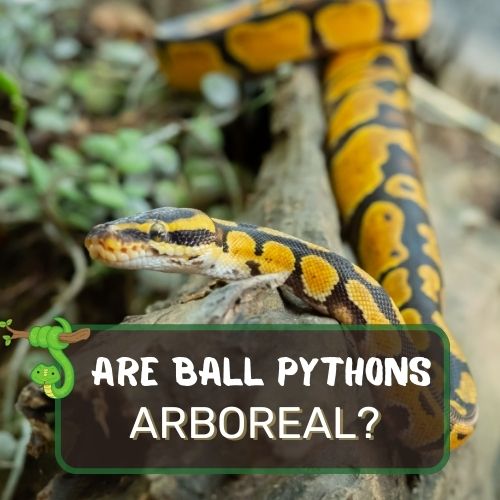
When the question “Are ball pythons arboreal?” arises, it sparks a fascinating exploration into the natural behaviors and habitats of these captivating reptiles.
Ball pythons, with their mesmerizing patterns and docile nature, have long been a favorite among reptile enthusiasts.
But do they prefer the treetops or the ground beneath?
In this article, we’ll delve deep into the characteristics of arboreal snakes, the natural behavior of ball pythons in the wild, and how they behave in captivity.
By examining factors like their morphology, climbing tendencies, and anecdotal evidence, we aim to provide a comprehensive answer.
Dive in to uncover the mysteries of the ball python’s arboreal tendencies and gain insights that could enhance your understanding and care of these remarkable creatures.
Table of Contents
Are Ball Pythons Arboreal? Short Answer
Ball pythons, native to the grasslands of West and Central Africa, are primarily terrestrial creatures. While they are adept at burrowing and often seek refuge in termite mounds or abandoned burrows, they aren’t naturally tree-dwelling or arboreal. However, in captivity, some ball pythons might occasionally climb branches or structures provided in their enclosures, leading to some misconceptions. This climbing behavior doesn’t classify them as arboreal.
It’s essential to differentiate between occasional climbing activities and a species’ natural habitat preference. In summary, while ball pythons might show some climbing tendencies, they are not considered arboreal snakes.
Characteristics of Arboreal Snakes
When we talk about arboreal snakes, we’re referring to those serpents that have evolved to spend a significant portion of their lives in trees. Let’s dive into what makes a snake truly arboreal.

What Are Truly Arboreal Species
Take the Asian Vine Snake, for instance. This slender, elongated reptile has a unique, almost whip-like body, allowing it to navigate the treetops with ease.
Its prehensile tail acts as an additional limb, providing grip and balance as it moves from branch to branch.
Then there’s the Green Tree Python. Its vibrant green coloration is perfect for blending into the dense foliage of its rainforest habitat.
When resting, it coils around branches in a distinctive saddle position, a behavior rarely seen in terrestrial snakes.
Comparison of Arboreal vs. Non-Arboreal Snake Morphology
When we delve into the world of snakes, the differences between arboreal and non-arboreal species become strikingly clear. Each group has evolved specific physical traits that best suit their respective environments.
Body Structure
Arboreal snakes, like the Green Tree Python or the Emerald Tree Boa, typically have long, slender bodies. This streamlined shape allows them to navigate the treetops with ease, moving gracefully between branches.
Their lightweight build minimizes the risk of branches breaking under their weight.
In contrast, non-arboreal snakes, such as the Ball Python or the Boa Constrictor, have a more robust and stocky build. Their bodies are designed for strength and power, allowing them to constrict their prey with immense force.
Their girthy structure is more suited for ground movement, providing stability and strength as they navigate terrestrial terrains.
Tail Adaptations
Many arboreal species possess prehensile tails, which act almost like a fifth limb. This tail adaptation provides an additional grip, crucial for stability when navigating the high canopies.
Non-arboreal snakes lack this adaptation, as their tails are more optimized for other functions, such as aiding in constriction or burrowing.
Head and Eye Position
Arboreal snakes often have a more triangular head shape with forward-facing eyes. This positioning offers a binocular vision, allowing them to judge distances effectively – a critical skill when leaping or striking from one branch to another.
On the other hand, terrestrial snakes have eyes positioned more on the sides, providing a broader peripheral view, essential for spotting ground-level threats or prey.
How Ball Pythons Measure Up Against These Characteristics
Now, let’s consider the Ball Python. It’s stocky, with a more rounded body shape – not the slender form of a typical tree-dweller.
Its eyes are positioned more on the sides of its head, and it lacks the prehensile tail that many arboreal species possess. Morphologically speaking, the Ball Python doesn’t quite fit the arboreal bill.
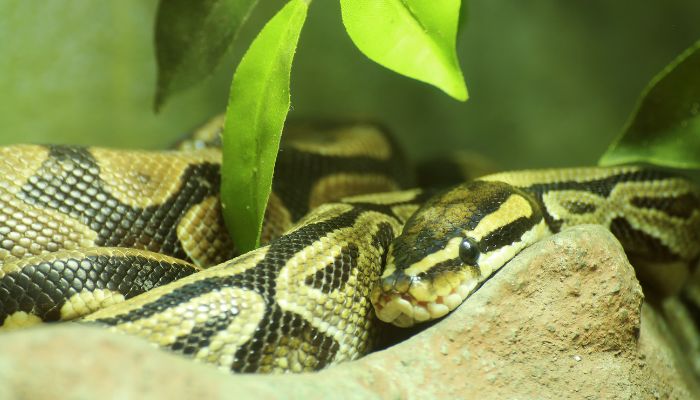
Ball Pythons in the Wild
To truly understand the behavior of Ball Pythons, we need to look at their natural habitat and how they behave in the wild.
Their Terrestrial Nature and Behavior in Their Natural Habitat
Ball Pythons are native to the grasslands and savannahs of West and Central Africa. Here, they’re more likely to be found burrowing or hiding in abandoned mammal burrows than hanging out in trees.
Their body structure is optimized for a life close to the ground, where they can easily ambush prey.
Occasional Climbing Due to Reasons Like Floods or Hunting
That’s not to say Ball Pythons never climb. In regions prone to flooding, these snakes might ascend trees or shrubs to escape rising waters. Additionally, young pythons might climb shrubs or low trees in pursuit of prey.
But these instances are exceptions rather than the rule.
Anecdotal Evidence from Local Snake Hunters
Local snake hunters in regions like Ghana, Togo, and Benin often share tales of Ball Pythons. While they occasionally encounter these snakes in shrubs or low trees, the vast majority of their sightings are on the ground.
These anecdotes further cement the Ball Python’s reputation as a primarily terrestrial creature.
Climbing Behavior in Captivity
When Ball Pythons are kept in captivity, their behavior can sometimes deviate from what’s observed in the wild. This is particularly true when it comes to climbing.
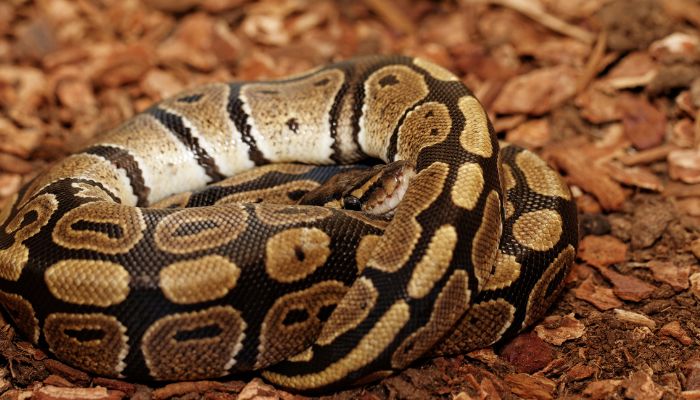
Reasons Ball Pythons Might Climb in Captivity
In a captive setting, Ball Pythons might climb for a variety of reasons. Curiosity is a significant factor. With a controlled environment and regular feeding, these snakes might explore their surroundings more than they would in the wild.
Additionally, if the temperature gradient in the enclosure isn’t optimal, they might climb to seek a more comfortable spot, especially if the heat source is positioned above.
The Difference Between Occasional Climbing and Being Arboreal
It’s crucial to differentiate between a snake that occasionally climbs and one that’s genuinely arboreal. Just because a Ball Python might ascend a branch or structure in its enclosure doesn’t mean it’s a tree-dwelling species.
True arboreal snakes have evolved specific physical adaptations to live in trees, as discussed earlier. Occasional climbing in captivity is more about exploration and comfort than a natural arboreal tendency.
Importance of Understanding Their Natural Behavior When Setting Up Enclosures
When setting up an enclosure for a Ball Python, it’s essential to mimic its natural habitat as closely as possible.
Understanding their primarily terrestrial nature can guide the design and setup, ensuring the snake feels secure and behaves as naturally as possible.
Ideal Environment for Ball Pythons
Creating an ideal environment for Ball Pythons in captivity is crucial for their well-being and longevity.
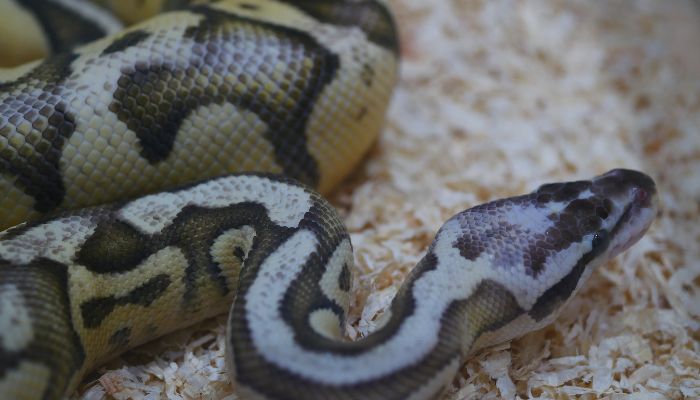
Importance of Wider Enclosures Over Taller Ones
Given their terrestrial nature, Ball Pythons benefit more from horizontal space than vertical. A wider enclosure allows them to roam, explore, and hunt (or approach their food) in a manner that’s more in line with their natural behavior.
While they might occasionally climb, they don’t require the vertical space that true arboreal species do.
Providing Hiding Places and Ground Exploration Opportunities
In the wild, Ball Pythons often hide in burrows or under vegetation. In captivity, providing multiple hiding spots can help them feel secure. These can be in the form of caves, hollow logs, or other suitable hideaways.
Ground exploration opportunities, like substrates they can burrow in or objects they can slither around, can also stimulate natural behaviors.
The Possibility and Benefits of Adding Climbing Accessories Without Making Them the Primary Focus
While climbing structures aren’t a necessity for Ball Pythons, adding a few can enrich their environment. Branches or low platforms can offer variety and stimulation.
However, these should complement the enclosure rather than dominate it. The primary focus should always be on creating a habitat that mirrors their natural, ground-dwelling tendencies.
If you do add climbing accessories, ensure they’re sturdy and safe, reducing the risk of falls or injuries.
Benefits of Climbing for Captive Ball Pythons
While Ball Pythons are primarily terrestrial creatures, providing them with opportunities to climb in captivity can offer several benefits. Let’s delve into why climbing can be advantageous for these fascinating reptiles.
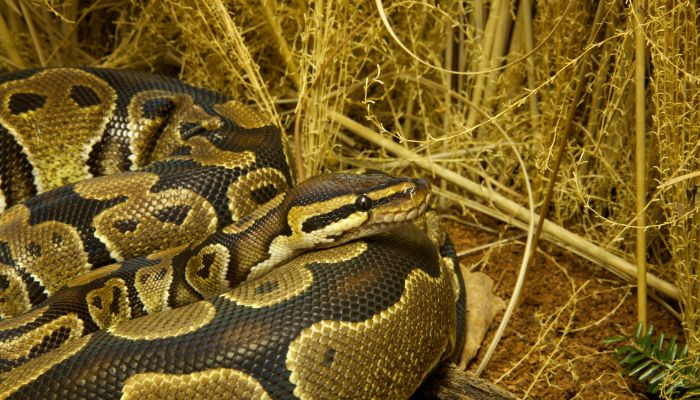
Enrichment and Exercise
In the wild, snakes face various challenges that keep them active and alert. In captivity, their environment is more controlled, which can sometimes lead to a lack of physical activity.
By introducing climbing structures, we can encourage Ball Pythons to use their muscles and engage in behaviors they might not typically exhibit in a flat enclosure.
Climbing can serve as a form of exercise, helping to maintain their muscle tone and overall health. Just like humans benefit from varied workouts, snakes too can gain from different forms of physical activity.
Mental Stimulation and Exploration
Imagine being in the same room every day with no change in scenery or activities. It would get monotonous, right? The same goes for captive animals. Ball Pythons, like all creatures, need mental stimulation.
Introducing climbing structures can break the monotony of their environment. The act of exploring a new branch or platform can trigger their natural curiosity, keeping their minds active.
Furthermore, climbing can offer a different vantage point, a new perspective of their surroundings, which can be intriguing for them. It’s akin to us finding a new path in a familiar park; the change, though small, can be refreshing.
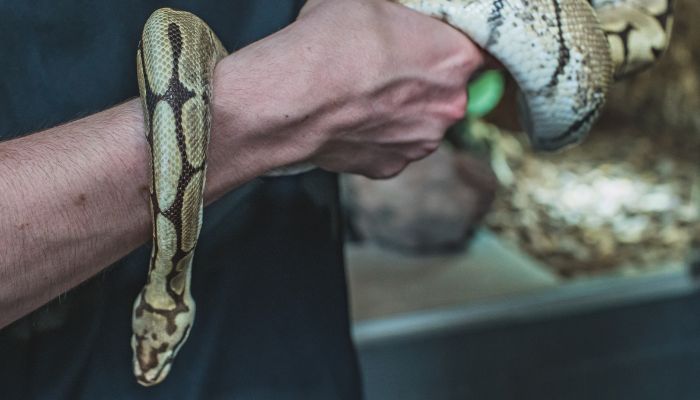
Final Word
As you’ve journeyed through this article, you’ve unraveled the intriguing question: are ball pythons arboreal?
We’ve explored the natural habitats of these captivating creatures, delved into the characteristics of arboreal versus terrestrial snakes, and examined their behavior both in the wild and in captivity.
It’s evident that while ball pythons might occasionally exhibit climbing tendencies, especially in captive settings, their true nature leans more towards the ground.
Understanding this distinction is crucial, not just for the sake of knowledge but also for providing the best care if you’re a proud ball python owner or enthusiast.
Remember, every creature, from the tiniest insect to the most majestic of mammals, has its unique behaviors and preferences shaped by evolution and environment.
By respecting and understanding these nuances, you’re not only enhancing the well-being of these animals but also enriching your own learning journey.
Keep that curiosity alive, continue to seek knowledge, and always strive to be the best guardian for the creatures in your care. Your dedication and passion make all the difference!
Frequently Asked Questions
Ball pythons, with their docile nature and captivating patterns, have become increasingly popular as pets. Naturally, potential and new owners often have a plethora of questions about their care and behavior. Let’s address some of the most common queries.
What Kind of Habitat Do Ball Pythons Prefer?
Ball pythons are native to the grasslands and savannahs of West and Central Africa. In the wild, they prefer terrestrial habitats, often burrowing or seeking refuge in abandoned mammal burrows. They thrive in warm temperatures with a gradient, allowing them to choose their comfort zone.
Do Ball Pythons Go in Trees?
While ball pythons are primarily ground-dwellers, they might occasionally climb shrubs or low trees, especially when young or in specific situations like escaping floods. However, they aren’t naturally tree-dwelling or arboreal like some other snake species.
What Do Ball Pythons Like in Their Cages?
In captivity, ball pythons appreciate an environment that mimics their natural habitat. This includes a warm temperature gradient, a substrate they can burrow in, and hiding spots. While they might explore climbing structures if provided, their primary needs are ground-focused.
Do Ball Pythons Need a Hiding Spot?
Absolutely! Hiding spots are crucial for ball pythons. In the wild, they often hide to feel secure and avoid predators. In captivity, hiding spots, like caves or hollow logs, provide them with a sense of security and can reduce stress, ensuring they feel safe and comfortable in their environment.




0 Comments